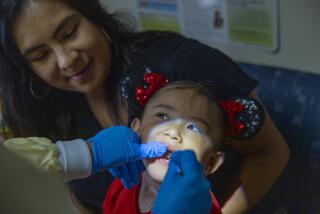Islanders’ Dentist Visits Focus on Extractions
- Share via
MAJURO, Republic of the Marshall Islands — Jack Shannon, the last U.S. Public Health Service dentist in the Marshall Islands, would like to be brightening smiles all over the land.
Instead, the wiry, crew-cut former missionary, who heads the only dental practice in this former U.S. Trust Territory, spends most of his time in a cramped hospital clinic here pulling rotten teeth.
“I’ve seen 6-year-olds with 18 decayed teeth,” he says. “The most [teeth] they can have is 24.”
An increasingly Western diet heavy with highly refined food and sugar arrived with the Americans after World War II, and now it is turning Marshallese teeth to mush.
And it is likely to get worse. Now that the Marshalls are politically independent, the U.S. government is cutting back on aid. Shannon’s job will vanish as soon as he gives it up.
At the same time, the Marshallese government’s falling revenues are pinching staff and supplies at Shannon’s clinic, which provides the only dental care available in this far-flung Pacific nation of 60,000 people.
“In all developing economies, dental care seems to be the last health area to be addressed,” Shannon says. “If you don’t have money to put food on the table, dental care just takes a back seat.”
So Shannon, 56, and two expatriate Burmese dentists, aided by two Marshallese dental nurses trained in Fiji, do the best they can.
Their clinic occupies one end of a wing at Majuro Hospital--a white, one-story prefabricated building moldering in the tropical heat and humidity. There are five dental chairs, four of which work. The space is air-conditioned when the system is functioning. Most months, Shannon says, the clinic sees about 900 patients; in July, it set a record of 1,044 patients.
Shannon and his staff do their own paperwork and make both full and partial denture plates--25 sets in July alone. Even so, “we can’t come anywhere near making all the dentures we need, given all the teeth we pull,” he says.
Dental health education is almost nonexistent here, and people generally do not take care of their teeth. As a result, more than half of the 1,044 people seen in July had teeth pulled, a statistic that would astound the average family dentist in the States.
“On Monday, I was alone here,” Shannon says. “I treated 45 patients. I started at 9 o’clock and I had four appointment patients for fillings, and the rest were all walk-in emergencies. I put in nine fillings and pulled 46 teeth.
“It’s frustrating,” he says. “But at least we’re relieving pain.”
Shannon manages the volume only because he rarely stops to X-ray first. “Ninety-five percent of the time you never run into a complication. If you do, and the tooth is not coming out, you take an X-ray of the root and find the problem.”
As busy as they are, Shannon’s staff would be overwhelmed if the Marshallese did come in for regular preventive care. “We would probably have to double the size of the clinic and add three or four more dentists,” he says, “which isn’t going to happen, I’m afraid.”
With so many patients, Shannon is well known on the streets of Majuro. He drives a tiny white Suzuki pickup, and his off-hours dress runs to khaki shorts, sandals and T-shirts. He speaks quietly and modestly, his eyes wrinkling with wry humor from behind trifocal lenses.
He grew up in the old Belgian Congo [later Zaire], where his parents were missionaries. He received his dental education at the University of Illinois and later joined the Public Health Service to expand his training so he could return to Africa as a dental missionary.
“I guess it’s part of being of service to mankind,” he says of his missionary instincts. “It’s a vehicle for spreading the Gospel.”
In 1972 he returned to Africa, working in an urban dental clinic in Kananga, Zaire. But he fell ill and eventually had to return with his wife and three children to the United States. He later served with the Public Health Service in Memphis, Tenn.; Norfolk, Va.; and at Indian Health Service clinics in Oklahoma and New Mexico before deciding in 1991 to fill a slot in the Marshall Islands.
“I jumped on it,” he said. “I’ve always loved the ocean, and I like warm climates, and I’d always wanted to have a sailboat.”
He got the first two and spends his free time fishing and scuba diving. The Public Health Service pays him $100,000 a year--modest by standards in the States. His Burmese colleagues are paid $29,000 each by the Marshallese government.
But Shannon’s dream of packing a sailboat with portable dental gear and sailing to treat patients on remote Pacific islands died when the sailboat he bought was damaged en route to Majuro and could not be fixed.
So he labors on at Majuro Hospital. Divorced, he is alone now except when his children come to visit. Two daughters stayed for a year and taught in local schools.
He works in the face of mounting dental decay in the islands. The refined Western diet has all but replaced the fish, breadfruit, pandanus, taro and tropical fruits the Marshallese traditionally ate.
“It’s devastating their teeth,” he says. Once a problem mostly in the more urban islands of Majuro and Ebeye, the sugar plague is spreading to the outer islands as more air links--and easier food shipments--are set up.
“On Friday . . . I had a 3-year-old with four front teeth that had to be pulled. They were rotted off at the gum line and abscessed,” he says. “It tears me up to do it, but it’s the only thing that’s going to help them.”
For the first five years he was here, Shannon established a sealant program in the Majuro schools to protect the molars of some children. Then the money ran out.
In the last two years, his survey of 6-year-olds in the schools showed the average decay rate climbing from fewer than five decayed teeth per child to seven.
He would like the government to add fluoride to the Majuro water supply--rainwater drained from the airport runway. But many residents prefer the rainwater captured from their own roofs. They use it to dilute the city water, so there would be no way to assure the population an effective dose.
Shannon’s attempts to have schoolteachers distribute fluoride tablets also failed. So have his efforts to establish annual dental missions to the Marshalls’ outer islands. There just isn’t the time or the personnel.
Shannon says he will serve perhaps three more years, until he reaches the maximum 30 years with the Public Health Service.
He will not be replaced. The PHS has already lopped three physicians and a nurse-midwife from its Marshall Islands service. Shannon is the last, and the local government is unlikely to take up the slack.
“There’s no way the Marshallese could afford our salaries here,” Shannon says. The island government is already behind in paying for the clinic’s dental supplies. That has led his suppliers to demand payment in advance.
Shannon has gotten by with help from a dentist friend in Hawaii, who puts the charges on his own credit card until Shannon gets the government to pay.
“The job is very frustrating here,” Shannon says. “But they need someone.”
More to Read
Sign up for Essential California
The most important California stories and recommendations in your inbox every morning.
You may occasionally receive promotional content from the Los Angeles Times.













